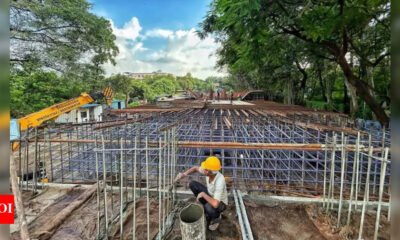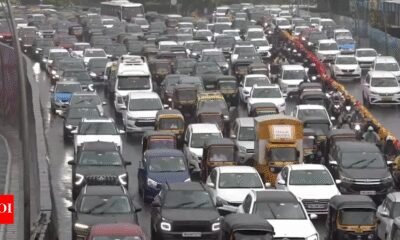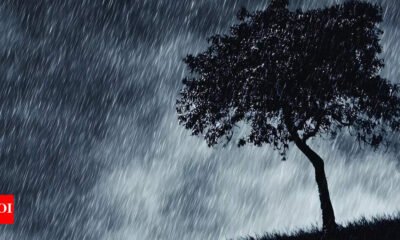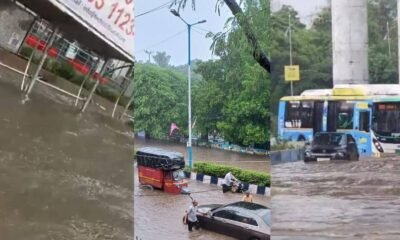Travel Guides & Articles
IMD says rain intensity likely to ease from today; safe to travel via ghat areas | Pune News

Travel Guides & Articles
Asia’s 8 greatest safari adventures involving unique wildlife – The Times of India
Travel Guides & Articles
Explore India’s best stargazing spots, tips for first-timers, and expert insights from space enthusiasts

Ever thought of planning a trip just to watch the stars? A few years ago, my son and I set up our telescope under a dark sky, and it felt like the universe had rolled out a welcome mat just for us. In the city, stars hide behind lights and smog, but in a remote spot, the Milky Way stretches like spilt silver across the sky, and meteors streak past like cosmic fireworks. Stargazing has become a way to travel, camp, and explore the cosmos all at once. Pachmarhi in August shows the Milky Way like nothing else, and the Rann of Kutch in winter turns into a meteor shower stage where the sky feels endless.
The lure of dark skies
Light pollution blurs the stars in most cities and makes the sky feel flat. Step into a dark-sky location and suddenly every star pops and constellations snap into focus. It is like switching from a blurry photograph to a high-definition image. Stargazing has become a travel trend because it slows you down. You lie on a blanket, point a telescope at Saturn or distant nebulae and just breathe. Watching meteors streak across the sky feels like the universe is giving you a wink.
India’s celestial hotspots for astro tourism
Rann of Kutch, Gujarat.
HT Lifestyle asked Nishant Gor from Stargazing India about his favourite stargazing spot. He said, “The white salt flats stretch forever, and the sky opens wide above you. Kutch is my number one spot for stargazing. I love how there is endless space to set up my gear and no obstructions to block the view. The Milky Way arcs over the horizon and meteor showers streak past in winter. Telescopes reveal rings, moons, and craters like never before.”
Pachmarhi, Madhya Pradesh.
August brings the clearest skies over this plateau. It is quiet, it is calm, and the Milky Way feels close enough to touch. Families and amateur astronomers can set up telescopes and watch the universe put on a show.
Spiti Valley, Himachal Pradesh.
Remote villages sit high in the mountains, and city lights cannot reach them. The night sky is crisp and clear. You can see the Milky Way glow and nebulae shimmer. Each night feels like an invitation to explore the deep sky.
Coorg, Karnataka.
In the south, Coorg has clear skies at the right seasons. Hilltops and coffee plantations make for peaceful stargazing spots. Binoculars or small telescopes uncover planets and constellations in a calm, cosy setting.
Uttarakhand, Himalayas.
With its high altitude and crisp mountain air, Uttarakhand opens up some of the clearest skies in India. Pruthu Vanara, a 23-year-old astro-photographer, told HT Lifestyle, “At higher altitudes, the clarity is breathtaking. You can see deep-sky objects like the Andromeda Galaxy and the Orion Nebula with exceptional detail.” Warm clothing is essential as the temperature drops quickly at night. A star chart or stargazing apps make the experience easier to follow, and telescopes or binoculars take you deeper into the cosmos.
Essential tips for the first-time stargazer
Plan your trip around a new moon. A full moon makes the sky too bright and washes out faint stars and the Milky Way. Apps like SkyView or Star Walk can show moon phases well in advance.
Even in warm regions, nights under open skies can get chilly. Bring a jacket, hat, and warm socks. Sitting still for hours can feel colder than expected.
Lie down on a blanket or sit on a camping chair. It makes long stargazing sessions comfortable and keeps your eyes steady on the sky.
Red light preserves night vision while still helping you move around safely. White light can ruin your dark adaptation in seconds.
- Binoculars are your friend
You don’t need an expensive telescope to enjoy the sky. Even small binoculars reveal craters, moons, and brighter nebulae.
- Start with constellations
Learn a few key constellations first. Orion, Ursa Major, and the Southern Cross are easy to find and will help orient you.
Stargazing can take a few hours. Having some light snacks and water keeps you comfortable without disturbing your night.
Clear skies are everything. Check local forecasts and avoid nights with clouds or high humidity.
Stargazing is not just looking at stars. It is stepping into awe, exploring planets, and wandering across the Milky Way. With the right location, a telescope, or even just a blanket, the universe opens up. Next time you plan a getaway, pack your curiosity along with some warm clothes and a flashlight because the cosmos is ready for you.
Similar articles for you
Andaman’s untouched charms: A guide to your mindful island escape
Forget safaris: At Kolkata’s hidden zoo gem, watch exotic wildlife up close!
Tropic of Cancer, one of Bhopal’s underrated gems: Scenic drive you cannot miss
Disney Cruise is coming to Asia! A deep dive to help you get on board!
Chasing the Monsoon: Five Epic Indian Train Journeys Through the Rain-Kissed Countryside
Travel Guides & Articles
5 best trekking trails in India for beginners |

India has some of the most breathtaking landscapes that trekkers should definitely witness, whether they are beginners or seasoned trekkers. There are a lot of trails all over India that are safe and provide the perfect blend of adventure, natural beauty, and a glimpse into the cultural heritage of the trails. Along these forests, individuals witness alpine meadows, lush greenery, and high mountains.Let’s take a look at these trekking trails:Dayara Bugyal (Uttarakhand)
A high alpine meadow located in the Uttarkashi district of Uttarakhand. People can trek to this meadow by going through meadows rich in alpine flowers, and one also gets the chance to witness a snow wonderland during winters. While going through the trail, one can also look at the beautiful Mt. Bandarpunch and other Garhwal Himalaya peaks. The trek starts around the villages of Raithal and Barsu, and one goes through some beautiful landscapes. Once an individual reaches the destination, they can get a glimpse of the rich culture, such as the unique tradition of the Butter Holi festival.Nag Tibba (Uttarakhand)
Nag Tibba or ‘Serpent’s Peak’ is the highest peak in the Lesser Himalayan region of Uttarakhand. The trek to this peak starts from Mussoorie and Landour till Nag Tibba, which according to legends, is considered the abode of the snake deity Nag Devta. Hikers and trekkers go through some of the most awe-inspiring areas, and at Nag Tibba, they witness the panoramic views of the Bandarpoonch ranges and can also take blessings of the god, as a temple is located on top of the hill.Triund (Himachal Pradesh)
Triund is a small hill station located in the Kangra district of Himachal Pradesh and is also located in the lap of the Dhauladhar mountains. Hikers and trekkers, while trekking, would witness the beautiful view of the Dhauladhar mountains on one side and the Kangra valley on the other side. This is a tranquil trek that people of all age groups can trek through, and they can look at the lush green forests filled with oak, deodar, and rhododendron trees. Triund is worth the whole trekking as it provides the most exhilarating view.Chopta-Chandrashila (Uttarakhand)
Chopta is located in the lap of the Uttarakhand Himalayas and is surrounded by lush green forests with pine and deodar trees as well as rich in flora and fauna. People can trek from Chopta to Chandrashila as it offers great views. Trekkers can go through many treks and trails here to reach the most famous trekking destinations, Chandrashila and Tungnath, and they might also be able to spot some birds here, as the Chopta region is famous among bird watchers. The trek to Chandrashila offers panoramic views of the Himalayas and an awesome climate.Kalsubai Trek (Maharashtra)
The Kalsubai peak is located in the Ahmednagar district within the Kalsubai-Harishchandragad Wildlife Sanctuary. This is the highest peak in Maharashtra and is also a quite famous destination among trekkers and adventure seekers. Trekkers trekking to the peak can witness a rich biodiversity with dense forests, rocky mountains, and some rare plant species. The base village, Bari, serves as the starting point for the trek and offers breathtaking views of the Western Ghats.
-

 Business3 weeks ago
Business3 weeks agoThe Guardian view on Trump and the Fed: independence is no substitute for accountability | Editorial
-
Tools & Platforms1 month ago
Building Trust in Military AI Starts with Opening the Black Box – War on the Rocks
-

 Ethics & Policy2 months ago
Ethics & Policy2 months agoSDAIA Supports Saudi Arabia’s Leadership in Shaping Global AI Ethics, Policy, and Research – وكالة الأنباء السعودية
-

 Events & Conferences4 months ago
Events & Conferences4 months agoJourney to 1000 models: Scaling Instagram’s recommendation system
-

 Jobs & Careers3 months ago
Jobs & Careers3 months agoMumbai-based Perplexity Alternative Has 60k+ Users Without Funding
-

 Podcasts & Talks2 months ago
Podcasts & Talks2 months agoHappy 4th of July! 🎆 Made with Veo 3 in Gemini
-

 Education2 months ago
Education2 months agoMacron says UK and France have duty to tackle illegal migration ‘with humanity, solidarity and firmness’ – UK politics live | Politics
-

 Education3 months ago
Education3 months agoVEX Robotics launches AI-powered classroom robotics system
-

 Podcasts & Talks2 months ago
Podcasts & Talks2 months agoOpenAI 🤝 @teamganassi
-

 Funding & Business3 months ago
Funding & Business3 months agoKayak and Expedia race to build AI travel agents that turn social posts into itineraries


















